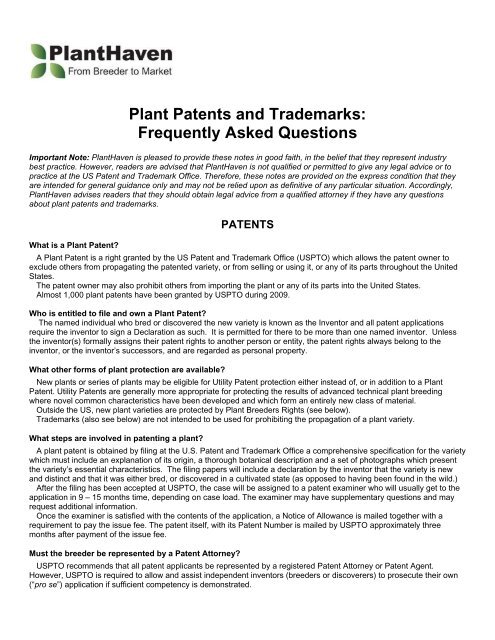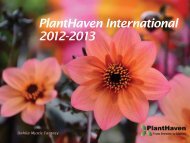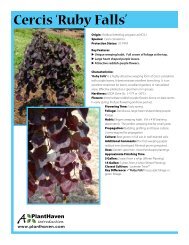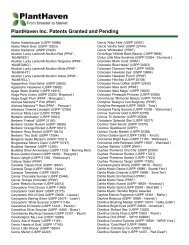Plant Patents and Trademarks: Frequently Asked ... - PlantHaven
Plant Patents and Trademarks: Frequently Asked ... - PlantHaven
Plant Patents and Trademarks: Frequently Asked ... - PlantHaven
Create successful ePaper yourself
Turn your PDF publications into a flip-book with our unique Google optimized e-Paper software.
<strong>Plant</strong> <strong>Patents</strong> <strong>and</strong> <strong>Trademarks</strong>:<br />
<strong>Frequently</strong> <strong>Asked</strong> Questions<br />
Important Note: <strong>Plant</strong>Haven is pleased to provide these notes in good faith, in the belief that they represent industry<br />
best practice. However, readers are advised that <strong>Plant</strong>Haven is not qualified or permitted to give any legal advice or to<br />
practice at the US Patent <strong>and</strong> Trademark Office. Therefore, these notes are provided on the express condition that they<br />
are intended for general guidance only <strong>and</strong> may not be relied upon as definitive of any particular situation. Accordingly,<br />
<strong>Plant</strong>Haven advises readers that they should obtain legal advice from a qualified attorney if they have any questions<br />
about plant patents <strong>and</strong> trademarks.<br />
What is a <strong>Plant</strong> Patent?<br />
PATENTS<br />
A <strong>Plant</strong> Patent is a right granted by the US Patent <strong>and</strong> Trademark Office (USPTO) which allows the patent owner to<br />
exclude others from propagating the patented variety, or from selling or using it, or any of its parts throughout the United<br />
States.<br />
The patent owner may also prohibit others from importing the plant or any of its parts into the United States.<br />
Almost 1,000 plant patents have been granted by USPTO during 2009.<br />
Who is entitled to file <strong>and</strong> own a <strong>Plant</strong> Patent?<br />
The named individual who bred or discovered the new variety is known as the Inventor <strong>and</strong> all patent applications<br />
require the inventor to sign a Declaration as such. It is permitted for there to be more than one named inventor. Unless<br />
the inventor(s) formally assigns their patent rights to another person or entity, the patent rights always belong to the<br />
inventor, or the inventor’s successors, <strong>and</strong> are regarded as personal property.<br />
What other forms of plant protection are available?<br />
New plants or series of plants may be eligible for Utility Patent protection either instead of, or in addition to a <strong>Plant</strong><br />
Patent. Utility <strong>Patents</strong> are generally more appropriate for protecting the results of advanced technical plant breeding<br />
where novel common characteristics have been developed <strong>and</strong> which form an entirely new class of material.<br />
Outside the US, new plant varieties are protected by <strong>Plant</strong> Breeders Rights (see below).<br />
<strong>Trademarks</strong> (also see below) are not intended to be used for prohibiting the propagation of a plant variety.<br />
What steps are involved in patenting a plant?<br />
A plant patent is obtained by filing at the U.S. Patent <strong>and</strong> Trademark Office a comprehensive specification for the variety<br />
which must include an explanation of its origin, a thorough botanical description <strong>and</strong> a set of photographs which present<br />
the variety’s essential characteristics. The filing papers will include a declaration by the inventor that the variety is new<br />
<strong>and</strong> distinct <strong>and</strong> that it was either bred, or discovered in a cultivated state (as opposed to having been found in the wild.)<br />
After the filing has been accepted at USPTO, the case will be assigned to a patent examiner who will usually get to the<br />
application in 9 – 15 months time, depending on case load. The examiner may have supplementary questions <strong>and</strong> may<br />
request additional information.<br />
Once the examiner is satisfied with the contents of the application, a Notice of Allowance is mailed together with a<br />
requirement to pay the issue fee. The patent itself, with its Patent Number is mailed by USPTO approximately three<br />
months after payment of the issue fee.<br />
Must the breeder be represented by a Patent Attorney?<br />
USPTO recommends that all patent applicants be represented by a registered Patent Attorney or Patent Agent.<br />
However, USPTO is required to allow <strong>and</strong> assist independent inventors (breeders or discoverers) to prosecute their own<br />
(“pro se”) application if sufficient competency is demonstrated.
If the inventor transfers his or her entire rights in the patent or patent application (an assignment) then that assignee<br />
may proceed to engage a patent practitioner or to prosecute the application pro se.<br />
When must a patent be filed?<br />
In general, a plant patent application must be filed within one year of the first date on which the variety was made<br />
available to the public (which includes the trade) anywhere in the world.<br />
<strong>Plant</strong>Haven advises that if the new variety is described in any publication, including the internet, then it is prudent to<br />
assume that the one year grace period has been started.<br />
How much does a patent cost?<br />
As of November 2009, the USPTO application fee for a plant patent is $720, <strong>and</strong> the issue fee is $1,190. These fees<br />
exclude the service fees charged by practitioners. A prudent estimate of total cost is in the range $2,750 - $4,000.<br />
Unlike patents for other inventions, no annual fees are due to USPTO for maintaining a <strong>Plant</strong> Patent.<br />
How long does a patent last?<br />
<strong>Plant</strong> patents are granted for a term of 20 years from the date of filing of the application.<br />
I am a wholesale grower: how can I grow a patented plant?<br />
The owner of the patent has the exclusive right to permit or prohibit propagation or distribution of a patented plant, <strong>and</strong><br />
may choose to exercise that right in order to be the sole producer <strong>and</strong> distributor of the variety.<br />
Alternatively, the patent owner may be interested in permitting others to grow the variety under license in return for a<br />
payment of royalties. Either the patent owner or his/her agent will decide whether to grant third party propagation rights,<br />
on what terms <strong>and</strong> to whom.<br />
I am a grower or a retailer or a l<strong>and</strong>scaper: why should I carry or use patented plants which<br />
will eat into my profit margin?<br />
Patented plants should be superior plants with significant <strong>and</strong> valuable commercial <strong>and</strong> performance benefits which<br />
more than outweigh the included royalty cost for the consumer.<br />
I am a breeder: how can I tell if a plant is worth patenting?<br />
The market will support the introduction of a patented variety, including its royalty level, if the variety carries benefits<br />
which justify the premium cost of the royalty <strong>and</strong> the new product development <strong>and</strong> marketing processes.<br />
It is best practice always to determine in advance, through market research <strong>and</strong> secure trials, that a variety will be taken<br />
up enthusiastically by the industry <strong>and</strong> be profitable for all parties.<br />
If a plant is worth patenting, <strong>and</strong> is properly managed, then it should be capable of delivering a sustained royalty stream<br />
for many years, or even for the entire life of the patent.<br />
How can I check if a plant is patented?<br />
All patented plants should display a tag <strong>and</strong> be listed in trade catalogues with a clear statement of the plant patent<br />
number. Granted plant patents can be looked up <strong>and</strong> researched on the website of USPTO: www.uspto.gov, using<br />
Search…<strong>Patents</strong>…Issued <strong>Patents</strong>.<br />
What is PPAF?<br />
PPAF is a term used by our industry to put others on notice that a variety is “<strong>Plant</strong> Patent Applied For.” It is equivalent to<br />
the term “Patent Pending”.<br />
The purpose of giving notice in this way is to forewarn others that a patent application is in process <strong>and</strong>, upon issuance,<br />
the plant concerned becomes instantly subject to the patent holder’s right to exclude all non-permitted activity. Thus,<br />
growers <strong>and</strong> propagators will often accept a license in order to be “gr<strong>and</strong>fathered in” to the expected issue of the plant<br />
patent.<br />
It is a Federal offence knowingly <strong>and</strong> erroneously to hold out a plant variety as Pending or PPAF.<br />
How can I check if a patent has been filed?<br />
All patent applications are maintained in secrecy until 18 months after their date of filing. At that point, applications may<br />
be searched on the website of USPTO: www.uspto.gov, using Search…<strong>Patents</strong>…Published Applications.<br />
However, USPTO regulations permit most plant applicants to request non-publication at 18 months, in which case the<br />
particulars are not publicly available until the patent is granted <strong>and</strong> issued.
Is it legal to breed from a plant protected by a <strong>Plant</strong> Patent?<br />
It appears that this question has not been definitively resolved in law. Some practitioners maintain that the original<br />
patent holder has the right to exclude others from using parts (including seed, pollen) of a patented variety in a deliberate<br />
breeding program. However, other practitioners have held that no such right or control exists after the patented plant has<br />
been purchased in open sale <strong>and</strong> the royalty has been paid. In effect, the original breeder’s rights have been exhausted,<br />
thereby rendering the variety free <strong>and</strong> clear.<br />
PLANT BREEDERS RIGHTS<br />
What is involved in protecting a plant overseas?<br />
The <strong>Plant</strong> Patent system is unique to the U.S. Other countries, including Canada, offer <strong>Plant</strong> Breeders Rights (PBR)<br />
protection for breeders.<br />
The overall PBR procedure is similar in all cases: the breeder or his representative files an application, which is then<br />
examined, <strong>and</strong> a grant of rights may follow in due course. However, compared with a patent application, there are some<br />
important differences, chiefly:<br />
• The breeder may have a longer “grace” period in which to file. Typically, a PBR application must be filed within one<br />
year of first date of sale within the application territory, or within 4 years of first date of sale outside the application<br />
territory. In the case of trees or vines, the 4 year term may extend to 6 years.<br />
• The examination process requires test plants to be submitted to official comparative trials against the nearest known<br />
cultivar. The c<strong>and</strong>idate variety will be assessed for its distinctness <strong>and</strong> stability, <strong>and</strong> may fail on either count.<br />
What are the costs <strong>and</strong> the duration of <strong>Plant</strong> Breeders Rights?<br />
The costs of obtaining a grant of PBR vary widely from territory to territory, being most expensive in Europe where the<br />
total cost (excluding any agents’ fees) is in the range €2,500 - €3,750 (approximately $3,750 - $5,625 in November<br />
2009).<br />
PBR applications cannot be processed by a non-resident of the application territory. It is required to engage a domestic<br />
representative who may also act as the breeder’s agent.<br />
In view of the potential for costs to accumulate from each territory of interest, it is important to make an early start on<br />
plant trials, <strong>and</strong> to utilize the permitted grace period to the full, in order to make reliable royalty revenue projections prior to<br />
incurring the costs of protection.<br />
Grants of PBR generally have longer terms than <strong>Plant</strong> <strong>Patents</strong>. A grant of PBR in Europe lasts for 25 years in general;<br />
30 years for trees <strong>and</strong> vines.<br />
Grants of PBR require payment of an annual maintenance fee in the region of $200 - $400.<br />
TRADEMARKS<br />
What is the difference between a trademark <strong>and</strong> a patent?<br />
Whereas (USPTO) “<strong>Patents</strong> protect inventions…<strong>Trademarks</strong> include any word, name, symbol, or device…used in<br />
commerce to identify <strong>and</strong> distinguish the goods of one manufacturer or seller from goods manufactured or sold by others<br />
<strong>and</strong> to indicate the source of the goods”.<br />
Only a patent has the ability to control (permit or exclude) propagation of a plant variety. A trademark does not provide<br />
this protection.<br />
What does TM mean, <strong>and</strong> what is meant by registration of a trademark?<br />
It is common to find the TM designation applied to goods or services, including plant names. This designation is used to<br />
put others on notice that trademark rights are being claimed in those goods or services. The TM designation does not carry<br />
the endorsement of having secured federal registration, which is denoted by use of the symbol ®.<br />
Federal registration of a claimed trademark follows after scrutiny by an examining attorney at USPTO <strong>and</strong> after a period<br />
of public notice <strong>and</strong> opportunity to oppose registration. <strong>Trademarks</strong> which are federally registered have a presumption of<br />
validity. In addition, the trademark owner enjoys the benefit that others may readily consult <strong>and</strong> verify the registered mark<br />
<strong>and</strong> its ownership on www.uspto.gov.<br />
<strong>Plant</strong>Haven believes that any person or company who aspires to build a reputation for their goods or services should<br />
consider obtaining federal registration of trademark or trademarks which denote <strong>and</strong> unite those goods or services with<br />
their origin.
<strong>Trademarks</strong> are good value: for a modest outlay, <strong>and</strong> with consistent <strong>and</strong> proper promotion <strong>and</strong> marketing, the owner<br />
will find that the trademark acquires over time significant value or br<strong>and</strong> equity which will be increasingly effective in<br />
maintaining differentiation in the marketplace.<br />
In <strong>Plant</strong>Haven’s experience, plant breeding programs <strong>and</strong> br<strong>and</strong>ed plant or nursery marketing programs are ideal<br />
subjects for trademark protection.<br />
How do I obtain Federal Registration of a proposed Trademark?<br />
The USPTO website is an excellent resource for learning the basic principles <strong>and</strong> procedures for applying for Federal<br />
registration. If an applicant feels fully conversant with the required procedures <strong>and</strong> formalities, <strong>and</strong> has conducted a prior<br />
search of registerability, then the applicant may elect to file electronically, without the use of a trademark attorney.<br />
The initial filing fee for federal registration of a trademark is $325 <strong>and</strong> a further fee of $100 will be due upon allowance –<br />
unless the trademark was filed on the basis of actual prior use in commerce.<br />
However, with such a modest fee, <strong>Plant</strong>Haven feels that it is prudent <strong>and</strong> worthwhile to consult in advance with an<br />
attorney with trademark expertise, who will generally indicate the advisability <strong>and</strong> methods of conducting a thorough<br />
search of registerability before proceeding.<br />
What about trademarks on plant variety names?<br />
USPTO maintains a clear position that varietal or cultivar names cannot be registered as trademarks. Further,<br />
trademark examiners are required to inquire of “plant” applicants whether their proposed trademark has any significance<br />
as a varietal name.<br />
USPTO, being concerned about possible confusion of the public in the marketing of plants, is opposed to the<br />
registration of any trademarks which are used to describe to the public a particular sort of plant, as opposed to a plant<br />
from a particular source.<br />
In principle, USPTO holds that it is common sense to provide the prospective purchaser with some common descriptive<br />
varietal name: a name which cannot then function as a trademark.<br />
© <strong>Plant</strong>Haven, Inc., November 2009<br />
PLANTHAVEN <strong>and</strong> FROM BREEDER TO MARKET are Registered <strong>Trademarks</strong> of <strong>Plant</strong>Haven, Inc.<br />
P.O. Box 3056 • Santa Barbara, CA 93130-3056<br />
Phone 805.569.9179<br />
Fax 805.569.6549<br />
Web http://www.planthaven.com<br />
Email new.plants@planthaven.com







